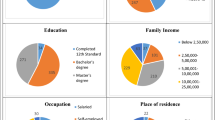Abstract
A social reputation loss model for loss of social reputation upon borrower disconnection on internet financial platforms is proposed. Firstly, the characteristics of on-line social networks of the borrowers are analysed from P2P platform, Chat platforms, QQ platform, one-click help platform, etc. Secondly, the characteristics of offline social networks of the borrowers are analysed in terms of blood, geographical, business, academic, heart, and ethnic relationships. Thirdly, from the six main factors, such as amount of default funds, disconnection time point, status of joint guarantee performance, project success probability, the amount and severity of network punishment, the impacts on the social reputation of lost-link borrowers are evaluated. Then, by quantifying these six main influencing factors, we establish a social reputation loss model on the lost-linking borrowers in P2P platform, and explore the relationship between borrower disconnection time and social reputation loss. The work proves that the social reputation loss of borrowers gradually decreases with the delay of disconnection time and other mathematical propositions. Finally, the applications of the model are discussed. The impacts of dynamic changes of the project success probability, disconnection time and amount of network punishment on the social reputation loss of borrowers are analysed. Through this study, an innovative calculating method for the loss of social reputation of borrowers who are out of touch on internet financial platforms is given.






Similar content being viewed by others
References
Jiang Y, Ho YC, Yan X, Tan Y (2018) Investor platform choice: herding, platform attributes, and regulations. J Manag Inf Syst 35(1):86–116
Wei S (2015) Internet lending in China: status quo, potential risks and regulatory options. Comput Law Secur Rev 31(6):793–809
Fang Z, Zhang J, Zhiyuan F (2014) Study on P2P E-finance platform system: a case in China. Int Conf e-Bus Eng 60(6):331–337
Zhao H, Ge Y, Liu Q, Wang G (2017) P2P lending survey: platforms, recent advances and prospects. ACM Trans Intell Syst Technol 8(6):1–28
Xu JJ, Chau M (2018) Cheap talk? The impact of lender-borrower communication on peer-to-peer lending outcomes. J Manag Inf Syst 31(1):53–85
Greiner ME, Wang H (2010) Building consumer-to-consumer trust in E-finance marketplaces: an empirical analysis. Int J Electron Commer 15(2):105–136
Inkpen AC, Tsang E (2005) Social capital, networks, and knowledge transfer. Acad Manag Rev 30(1):146–165
Yueh L (2009) Self-employment in urban China: networking in a transition economy. China Econ Rev 20(3):471–484
Kang M, Gao Y, Wang T, Zheng H (2016) Understanding the determinants of funders’ investment intentions on crowdfunding platforms: a trust-based perspective. Ind Manag Data Syst 116(8):1800–1819
Filieri R, McNally RC, O’Dwyer M, O’Malley L (2014) Structural social capital evolution and knowledge transfer: evidence from an Irish pharmaceutical network. Ind Mark Manag 43(3):365–381
Putterman L (2013) Institutions, social capability, and economic growth. Econ Syst 37(3):345–353
Liu D, Brass D, Lu Y (2015) Friendship in online peer-to-peer lending: pipes, prisms, and relational herding. MIS Q 39(3):729–742
Xu Y, Luo C, Chen D, Zheng H (2015) What influences the market outcome of online P2P lending marketplace? A cross-country analysis. J Glob Inf Manag 23(3):23–40
Ge R, Feng J, Gu B, Zhang P (2017) Predicting and deterring default with social media information in peer-to-peer lending. J Manag Inf Syst 34(2):401–424
Selmier WT (2018) Social capital and folk lending in China’s hottest financial market. Econ Polit Stud 6(1):69–90
Zhou W, Tsiga Z, Li B, Zheng S, Jiang S (2018) What influence users’ e-finance continuance intention? The moderating role of trust. Ind Manag Data Syst 118(8):1647–1670
Elham Majd, Vimala Balakrishnan (2016) A reputation-oriented trust model for multi-agent environments. Ind Manag Data Syst 116(7):1380–1396
Herbig P (2004) A model of reputation building and destruction. J Bus Res 31(1):23–31
Ekmekci M (2010) Maintaining a permanent reputation with replacements”, working paper, Northwestern University, 8 May
Hitchner E (1996) What’s in a name? Everything. Reputation: realizing value from the corporate image by Charles J. Fombrun. Boston: Harvard Business School Press. Natl Product Rev 15(2):107–112
Cripps MW (2004) Imperfect monitoring and impermanent reputations. Econometrica 72(2):407–432
Tadelis S (2002) The market for reputations as an incentive mechanism. J Polit Econ 110(4):854–882
Johannes H (2002) Reputation and competition. Am Econ Rev 92(3):644–663
Livingston JA (2005) How valuable is a good reputation? A sample selection model of internet auctions. Rev Econ Stat 87(3):453–465
Mccahery MJ, Schwienbacher A (2010) Bank reputation in the private debt market. J Corp Finan 16(4):498–515
Melnik MI (2002) Does a seller’s ecommerce reputation matter? Evidence from ebay auctions. J Ind Econ 50(3):337–349
Livingston M, Miller RE (2000) Investment Bank reputation and the underwriting of nonconvertible debt. Financ Manag 29(2):21–34
Jin GZ, Kato A (2006) Price, quality, and reputation: evidence from an online field experiment. RAND J Econ 37(4):983–1004
Fang LH (2005) Investment Bank reputation and the price and quality of underwriting services. J Financ 60:2729–2761
Song S, Hwang K, Zhou R, Kwok YK (2005) Trusted P2P transactions with fuzzy reputation aggregation. IEEE Internet Comput 9(6):24–34
Hakenes H (2007) Observable reputation trading. Int Econ Rev 48(2):693–730
Acknowledgments
The paper is supported by Natural Science Foundation of China (91646112); The Key Programmes of the Science and Technology Department of Guangdong Province (2016A020224001).
Author information
Authors and Affiliations
Corresponding author
Additional information
Publisher’s note
Springer Nature remains neutral with regard to jurisdictional claims in published maps and institutional affiliations.
This article is part of the Topical Collection: Special Issue on Future Networking Applications Plethora for Smart Cities
Guest Editors: Mohamed Elhoseny, Xiaohui Yuan, and Saru Kumari
Rights and permissions
About this article
Cite this article
Pang, S., Yang, J. Social reputation loss model and application to lost-linking borrowers in a internet financial platform. Peer-to-Peer Netw. Appl. 13, 1193–1203 (2020). https://doi.org/10.1007/s12083-019-00848-7
Received:
Accepted:
Published:
Issue Date:
DOI: https://doi.org/10.1007/s12083-019-00848-7




